A friend of mine asked me if she should use chiffon or tulle for her wedding dress. This wasn’t an easy question for me to answer. Chiffon and tulle are similar fabrics. They are both top of the list when it comes to formal gowns. So which should she use? Chiffon or Tulle? What is the difference?
The main difference between chiffon and tulle is the weave. Chiffon is a lightweight, simple weave with excellent drape. Tulle is a transparent, loose weave fabric with visible tiny holes. As a member of the mesh family, tulle is ideal for veils, skirt overlays, and underskirts. Chiffon is more opaque and perfect for the main dress or bodice.
In this article, you’ll learn how to tell the difference between tulle and chiffon. From the properties they have in common to the things that set them apart.
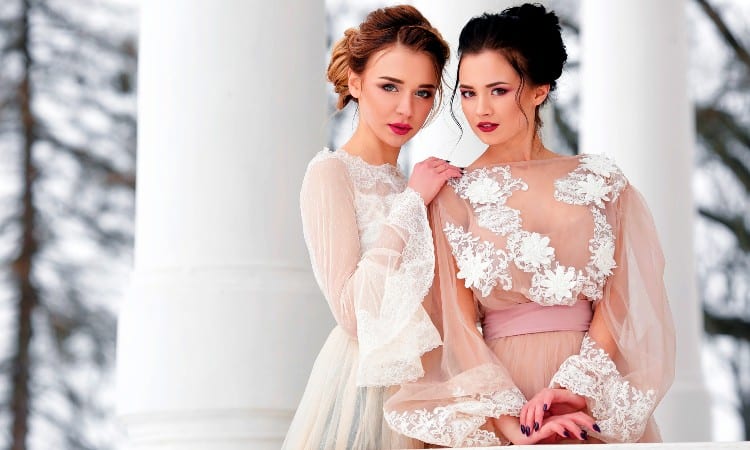
Quick Navigation
Chiffon vs Tulle: Key Points
Chiffon and tulle have similar functions in the garment industry. Both fabrics can be used in bridal wear and prom dresses. But, they each have individual properties that make them more suited to some projects and less ideal for others.
Tulle, for instance, is the fabric that springs to mind for structured items like fairy wings on fancy dress costumes. Or the frilly layers on tutus. Chiffon, on the other hand, is synonymous with delicate blouses and floaty scarves.
Yet both chiffon and tulle are used to produce wedding dresses. How is it possible that two dissimilar fabrics are perfect for formal bridal wear? The truth is, chiffon and tulle give a different feel to the finished dress. Tulle is more ethereal, while chiffon gives a more sensual vibe.
It’s no wonder it can be tricky to figure out the difference between tulle vs chiffon. Which one should you go for? It depends on the overall effect you are hoping for. This is why it’s important to be able to tell the two fabrics apart.
I’ve put together a table so you can compare and contrast the key points of chiffon vs tulle. Their properties and characteristics are listed in this handy visual, so you can see at a glance whether it’s tulle or chiffon you need for your next sewing project.
| Properties | Chiffon | Tulle |
|---|---|---|
| Appearance | Sheer almost weightless fabric | Sheer netting or mesh |
| Durability | Delicate Snags and frays easily | More durable than chiffon |
| Fit and Drape | Good drape can be closer-fitting than tulle sexier silhouette than tulle | Floaty and voluminous not suitable for figure-hugging garments more relaxed, romantic look |
| Feel | Soft and smooth, although it can feel slippery | Soft and smooth or crisp and smooth depending on the size of the mesh |
| Fiber Content | Nylon, polyester, silk | Cotton, lurex, polyester, silk, wool |
| Laundry | Hand wash or dry clean | Depends on the garment and fiber content of the tulle Either use a cold machine wash with no spin or hand wash |
| Layers Needed | Slightly opaque so requires fewer layers underneath | Needs layers underneath as it’s see-through netting |
| Use | Main fabric for wedding dresses, ballgowns, and prom dresses Lingerie, scarves, and ribbons | Accessories like veils, fascinators, fairy wings Frilly layers in tutus Creates volume underneath full skirts An overlay on formal skirts |
What Is Chiffon?
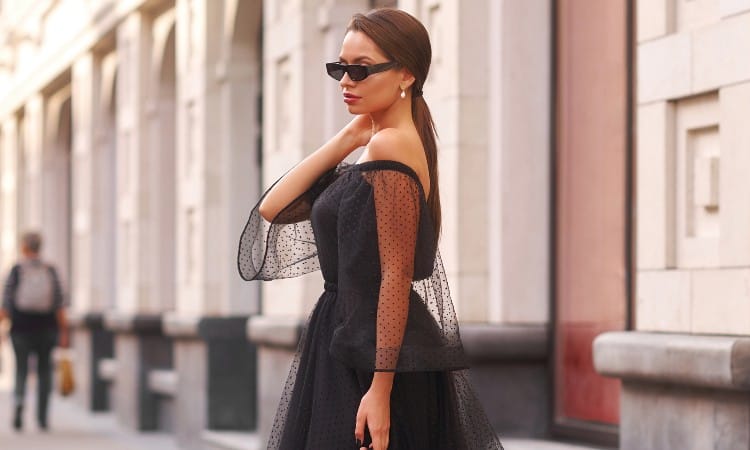
Chiffon has been around for a long time. Originally a fabric made from silk, it has been used for centuries as a clothing staple in Ethiopia, Eritrea, and India. Silk chiffon is cooling and incredibly comfortable to wear in hot climates.
Due to the expensive silk production process, silk chiffon became a buzzword for wealth and status. Not just on the continent of Africa or in India, but across the globe. Chiffon has always been linked to quality garments with a lustrous chic. It hasn’t always been called chiffon, though.
The name chiffon didn’t come into being until the fabric rose to popularity throughout the west in the early 20th century. Back then, the material was produced in France and naturally had a name derived from the French language. Chiffon is French for cloth.
These days chiffon is used to describe any material which is light and semi-transparent. The textile has a simple, loose weave of alternating “S” and “Z” twists. These twists give chiffon a slightly puckered appearance full of texture and elasticity.
Silk is and always has been an expensive textile to produce. So much so that manufacturers experimented with new fibers to make the production process cheaper. In 1938 a nylon chiffon was briefly introduced to the market. Unfortunately, it was short-lived due to the issues with early nylon materials.
Next came polyester chiffon in 1958. This was a more successful match and polyester has become the go-to fiber for affordable chiffon fabrics. You can also find chiffon made from cotton, rayon, and the much-improved modern nylon.
Thanks to polyester, chiffon is now available to the masses and no longer reserved for the rich or famous. If you want more traditional chiffon, you can still find the textile made from silk. However, the price tends to put it out of reach for all but the most expensive garments.
Pros and Cons of Chiffon
Chiffon is an attractive fabric to wear. Being both soft and luxurious, it can make you feel like the belle of the ball. It does have a few bad points, though. Let’s take a closer look at the pros and cons of chiffon.
Pros
- Lightweight and semi-sheer
- Drapable
- Cool in high temperatures
- Lustrous
Cons
- Delicate fabric
- Snags easily
- Difficult to work with
- Seams can pull apart when worn
- Needs support from a lining fabric
What Is Tulle?
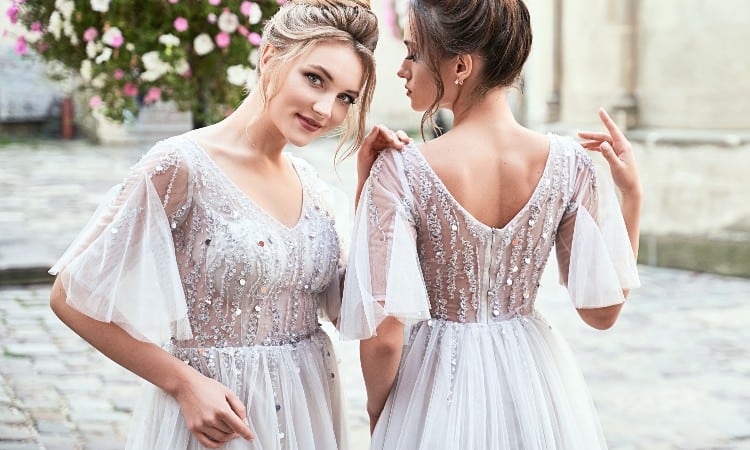
A member of the mesh family, tulle is a type of netting. It is a loosely woven fabric with visible tiny holes resembling mesh.
Like Chiffon, tulle can trace its origins back to France. This popular soft netting is named after the French city of Tulle, where it was first introduced. Originally it was made from silk and used for bridal accessories for generations. Most famously, Queen Elizabeth, the 2nd, used silk tulle for her bridal veil on the occasion of her marriage to the Duke of Edinburgh in 1947.
Tulle comes in a range of colors and because the textile is netting, most tulle fabrics are completely transparent. It has a lightweight, floaty feel that adds interest and movement to garments. One of the best-known uses of tulle is in tutus, where the fabric accentuates the delicate, fluid motions of the ballerina.
There is more than one type of tulle. From the lightest, most delicate silk tulle to the heavier, slightly stiffer English tulle. The differences in texture, feel, and weight makes the various tulle fabrics suitable for different tasks.
Of all the tulle fabrics, silk is the most delicate and rare. It’s the one most often used for bridal purposes. Nylon tulle is the most commonly used for dress overlays as it is the cheapest fiber available. In contrast, a polyester tulle is generally used for crafts as it has less flexibility.
Pros and Cons of Tulle
Tulle is a versatile fabric capable of creating volume in a garment and adding a hint of delicate movement. There are a few downsides with the material, though. Let’s take a look at the pros and cons of tulle.
Pros
- Will not fray or unravel
- Smooth and soft
- Lightweight and floaty
- Adds volume and interest to formal gowns
- Romantic silhouette
Cons
- Most tulle fabrics are completely transparent
- Difficult to work with due to the netting structure
- Seams will show through to the right side
What is the Difference Between Organza, Chiffon and Chiffon?
Organza is a sheer fabric with a lightweight plain weave. It has much in common with both chiffon and tulle. All three materials are delicate with the feel of fine gauze fabric.
Unlike chiffon, organza tends to be measured by holes per inch, or HPI, just like tulle. This is unique, considering organza isn’t classed as netting. Nor is it a member of the mesh family. It belongs to the family of transparent textiles along with chiffon.
Organza is a bit of a bridge between chiffon and tulle. It can be used for the same projects, from wedding dresses to tutus, with equal success.
So what is the difference between organza vs chiffon? Does it have more in common with tulle? Let’s take a closer look at organza.
Appearance
Organza is a stiffer fabric than chiffon with less fluidity. There is very little flow with organza and it works best in garments with more structure.
Although all organza textiles can be translucent up to a point, the fabric can come in various thicknesses ranging from ultra-thin to almost as thick as a canvas.
Due to the nature of organza, the weave can create a dull or matte finish to the fabric. It lacks the lustrous sheen of chiffon. However, some types like spark organza or pearl organza can have sparkles or pearlescent coloring added to the weave for extra interest.
Durability
The durability of organza can vary according to the fiber content within the weave. Silk organza is going to be more fragile than a synthetic version. In the main, though, as all organza textiles are lightweight sheer fabrics, they will be delicate to some degree.
Organza can be incredibly prone to snags, tears, and fraying, particularly if it is made from silk. On the flip side, depending on the fiber, organza can also be wrinkle-resistant and immune to pilling.
Breathability
The traditional fiber used in organza is silk. Because it’s natural, silk has built-in breathability. Silk organza is, therefore, going to be extremely breathable.
Even synthetic organza has breathability. Although synthetic fibers like polyester or nylon are not known to be breathable, the weave of the organza fabric makes up for that shortfall. It’s a loose, lightweight weave with rows of tiny, fine holes. Air just flows straight through.
Fit and Drape
With slightly less flexibility than chiffon, the drape offered by organza tends to be stiffer. This can create a more structured gown with a defined silhouette. Because of the rigidity of organza, pleats can be used to accentuate both the depth of color within a garment and a person’s figure.
Normally, the base fabric, like silk or satin, creates the fit, whether that be figure-flattering or more loose-fitting. Organza follows the lines of the bodice or skirt to create volume or interest.
Feel
Organza can feel crisp to the touch. It has an almost grain-like texture, reminiscent of fine sandpaper. It’s this crispness that gives organza its trademark stiffness. The stiffness is caused by the production process and is down to adding acid to the fibers before they are woven together.
The material can also feel like it has wire within it. This is also down to the stiffness of the material. It’s the wire-like texture that helps the material hold its shape and create structure.
Fiber Content
Originally made from silk, organza can also be made from polyester and nylon. These days synthetic versions are more readily available.
Not only are nylon and polyester cheaper, but they are also easier to care for. Silk tends to be reserved for more expensive, high-end garments and accessories.
Even synthetic organza can be extremely delicate. So much so, all organza is considered to be dry clean only to prevent the possibility of any damage to the fabric.
Layers Needed
Organza is transparent and needs to be used in layers. Normally, it is layered with opaque silk or satin material underneath. As a thin and lightweight textile, organza can be used to build structure in a garment. This can be accomplished by using several layers as either an overlay or underskirt.
It can also be used to create volume underneath a solid layer of fabric. For skirts in bridal gowns or prom dresses, some organza can help lift the main fabric, creating a fuller, poufier outline.
Best Uses
The best uses for organza mirror those of chiffon and tulle. As a transparent, sheer material, organza can be used as an overlay on skirts and bodices. It can add texture and interest to bridal wear and prom dresses. Organza can also be used to create volume underneath formal gowns.
You can use organza for blouses, scarves, and bridal veils. There is a use for organza that neither chiffon nor tulle gets used for. Organza can be used for home décor and is often found in curtains or lampshades.
Price
Although chiffon and organza can be expensive, organza tends to be more expensive than chiffon. Regardless of the fiber content, this is especially true if it is made from silk. The reason for that is simple. Production of organza is an intricate process.
Not only is the fabric woven in a specific way, but to ensure consistency, organza is still mostly woven by hand. A hands-on approach gives more control over things like fabric stiffness and appearance.
Chiffon vs Organza
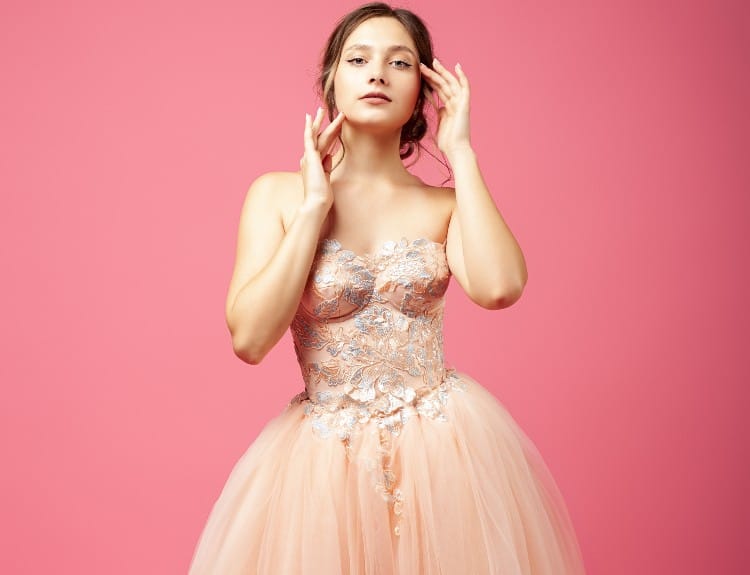
When it comes to choosing chiffon vs organza, the overall silhouette you are hoping to achieve plays a very large role. Although very similar, the two fabrics have different characteristics that will alter the look and feel of a garment.
Organza is the stiffer of the two textiles. With a wirey nature, it can be used to create structure in garments. You can incorporate pleats, tucks, and folds to add interest and texture. A no-nonsense look for formal occasions full of pomp and ceremony.
Chiffon has more drape and softness that adds fluidity to an outline. It has a delicate look and a softness that can be used to create a feminine silhouette with a hint of sophistication and decadence. A sultry, fresh feeling of romance and passion.
Chiffon vs Mesh
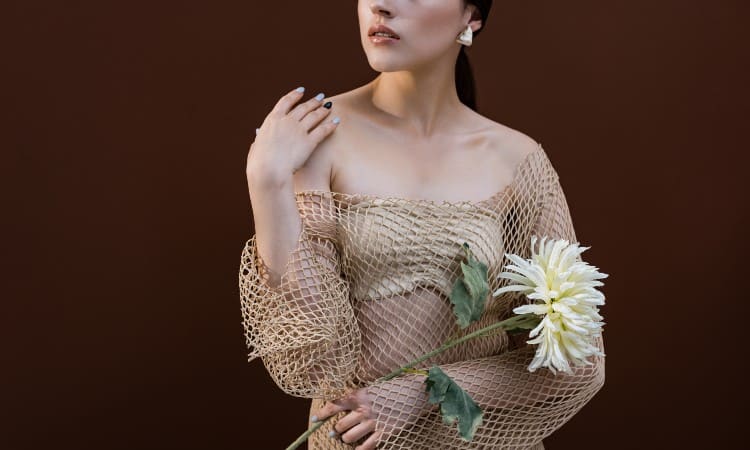
The main difference between chiffon and mesh is the appearance of the material. Chiffon is more recognizable as a delicate, luxuriant fabric. Whereas mesh is more like netting. We’ve looked at one type of mesh in this article already. Tulle is a member of the mesh family.
Tulle is one of the softer mesh varieties and is often used in bridal wear, either as an accessory like a veil or as an underlining to add volume. This is because it has properties that enable it to act more like a fabric than a netting.
Because of this, tulle is normally the only member of the netting family used for the same projects as chiffon. Other mesh fabrics don’t have the same delicate nature as tulle. Nor do they have the same draping qualities.
There are a couple of reasons for this. One is the size of the holes in the mesh. The other is different mesh fabrics are designed with specific projects in mind. Think power mesh, for instance. Power mesh or compression mesh is used in support wear and athletic garments. It’s not a fabric that can replace chiffon.
Organza vs Tulle
Organza is a crisp textile that has similar qualities to tulle. Unlike tulle, though, organza is a sheer fabric rather than netting. In that respect, it has more in common with chiffon.
While both organza and tulle can be used to make tutus, organza is the stiffer of the two materials. You can pleat or fold organza and it will hold the shape. Tulle, on the other hand, is too floaty and stretchy to stay in a structured form. It likes to be flexible and free-moving.
Of the two, you’ll find tulle is slightly less delicate to handle. Organza needs to the treated with gentle care. It can’t be machine washed. Nor can it be transported easily without protective coverings. Tulle, on the other hand, although still a delicate fabric, is a little more resilient.
Fabrics Similar to Chiffon
There are a few fabrics that have similar characteristics to chiffon. We’ve looked at two so far in this article. Both tulle and organza can be used instead of chiffon in formal wear and bridal gowns.
Other fabrics that can also resemble the properties of chiffon include georgette, batiste, gauze, lace, muslin, voile, and organdy. All these materials are members of the sheer family of textiles. They are also usually made from the same type of fibers. You’re looking at silk, cotton, nylon, and polyester.
The main difference between the materials is the weave and weight of the material. Georgette, for instance, is slightly more opaque than chiffon, while lace is more decorative. Organdy has a firmer feel and is often used as a stabilizer for transparent fabrics.
Which Is Better: Chiffon or Tulle?
The better fabric out of a choice of chiffon or tulle depends on the effect you are looking for. If you want an ethereal, romantic vibe, you should go for tulle. It moves better and looks fantastic in a twirl.
For a more sensual or sexy outline, consider chiffon. From an incredible drape to a luxuriant sheen, chiffon will make you feel like a goddess.
Both fabrics are a great choice for bridal wear and formal gowns. The one you go for is up to you and your preferences. Neither fabric is better than the other. But they do have individual properties that make them more suitable for some tasks.
Let me know in the comments if you liked the article. Have you ever worked with chiffon? Do you prefer tulle? Which one do you think will work best in your next project?